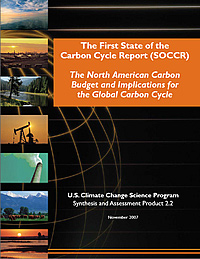Changing carbon cycle may worsen U.S. CO2 emissions
Changing carbon cycle may worsen U.S. CO2 emissions
Carnegie Institution
November 14, 2007
The first “State of the Carbon Cycle Report” for North America, released online this week by the U.S. Climate Change Science Program, finds the continent’s carbon budget increasingly overwhelmed by human-caused emissions. North American sources release nearly 2 billion tons of carbon into the atmosphere each year, mostly as carbon dioxide. Carbon “sinks” such as growing forests may remove up to half this amount, but these current sinks may turn into new sources as climate changes.
“By burning fossil fuel and clearing forests human beings have significantly altered the global carbon cycle,” says Chris Field of the Carnegie Institution’s Department of Global Ecology, one of the report’s lead authors. A result has been the buildup of carbon dioxide in the atmosphere, but so far this has been partially offset by carbon uptake by the oceans and by plants and soils on land.

|
“In effect, we have been getting a huge subsidy from these unmanaged parts of the carbon cycle,” notes Field. Overall, this subsidy has sequestered, or hidden from the atmosphere, approximately 200 billion tons of carbon. In North America much of it has come from the regrowth of forests on former farmland and the uptake of carbon by agricultural soils.
But these carbon sinks may be reaching their limit as forests mature and climate conditions change. And some may literally go up in smoke if wildfires become more frequent, as some climate simulations predict. Planting forests and adopting carbon-conserving practices such as no-till agriculture may increase carbon sinks somewhat, but this would not come close to compensating for carbon emissions, which continue to accelerate.
“There are a lot of good reasons for replenishing our forests and encouraging better agricultural practices,” says Ken Caldeira, another author of the report, also at Carnegie’s Department of Global Ecology. “But if we want to mitigate our impact on the carbon cycle, there’s no escaping the fact that we need to drastically reduce carbon dioxide emissions.”
The State of the Carbon Cycle (SOCCR) is funded by the Department of Energy (DOE), the National Aeronautical and Space Administration (NASA), the National Oceanic and Atmospheric Administration (NOAA), and the National Science Foundation (NSF).